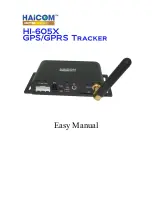
Neo_M660A GPRS Module Hardware User Guide
Copyright © Neoway Technology Co., Ltd
25
Figure 3-25
Coupling capacitor interfacing
GPRS Module
RECN
RECP
C1
C2
User's
Circuit
3.8
RF Interface
3.8.1 RF Design and PCB Layout
GPRS_ANT is the antenna interface of the module. A 50 Ω antenna is required. VSWR ranges from 1.0 to
1.5. The antenna should be well matched to achieve best performance. It should be installed far away from
high speed logic circuits, DC/DC power, or any other strong disturbing sources.
For multiple-layer PCB, the trace between the antenna pad of module and the antenna connector, should
have a 50 Ω characteristic impedance, and be as short as possible. The trace should be surrounded by ground
copper. Place plenty of via holes to connect this ground copper to main ground plane, at the copper edge.
If the trace between the module and connector has to be longer than 10 mm, or built-in antenna is used, a
π-type matching circuit should be added, as shown in Figure 3-26. The types and values of C1, L1, and L2
should be verified by testing using network analyzer instrument. If the characteristic impedance is well
matched, and VSWR requirement is met, just use a 0 Ω resistor for C1 and leave L1, L2 un-installed.
Avoid any other traces crossing the antenna trace on neighboring layer.
Figure 3-26
Reference design for antenna interface
GPRS Module
ANT
C1
GPRS_ANT
L2
L1
On two
-
layer boards which cannot control resistance properly, the RF route should be as short (less than 10
mm) and smooth as possible and at a width of 0.5 mm; the RF is 0.5 mm away from the ground.
Figure 3-27 shows a two-layer board application. The RF is connected to GSC RF connector through traces
on PCB, which is connected to the antenna via cable.










































